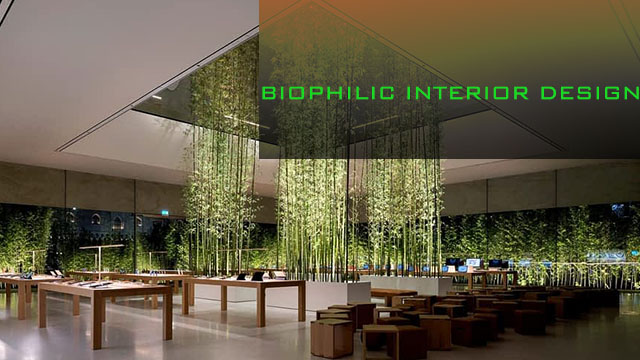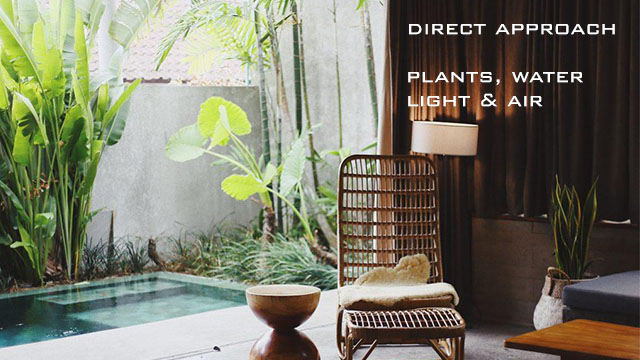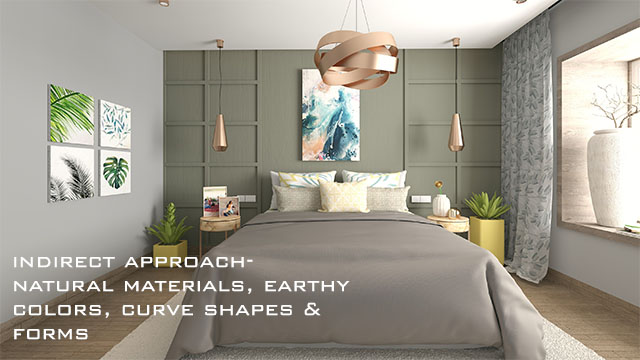Humans have passively accepted built-in unnatural spaces as an adobe, which lead to shrinking day-to-day connection with nature. Moreover, urbanization and lifestyle changes are resulting in an unhealthy byproduct of health and behavioral pattern. Therefore, the concept ‘Biophilic’ is rapidly sustaining into living spaces and is becoming a popular interior design trend.

Biophilia represents our inherent love for nature. In simple terms, the concept of biophilic is restoring the bond between humans and nature. Nature is the indigenous dwell that surrounds humans to nourish their life cycle. Hence, it performs a substantial positive impact on our health and well beings.
How does Biophilic work in interior design?
The biophilic design comprises strategies that ensure healthy air quality, comfortable temperatures, proper lighting, and calming visuals. Researches consistently suggesting, the spaces support us best when they echo the scale and tone of the natural environment. The three strategic connections that separate the biophilic component are the direct connections, the indirect connections, and the experience of spaces.
The direct connection
The first is what we call a direct connection to nature, which is a multi-sensory and robust process. Humans have evolved for a vast amount of time throughout evolution in a close connection to nature for basic survival. Although a misconception often associates that plants are the only biophilic elements that convey nature in space. But, the most important thing is understanding that nature embodies water, air, light organic patterns, and life forms. So integrating them into areas is the direct connection.

Plants
Plants are living-breathing organisms that don’t just look good but can make us feel good. The benefit that reconciles plants into indoor is their aptness to purify the air by absorbing various toxins that discharge through indoor automation and chemical cleaners. Further, foliage maintains humidity and produces sufficient oxygen, which improves air quality.
Potted and hanging plants, an indoor garden, living plant walls are few approaches to cherish visuals. Plants can also act as a visual barrier between work zones, provide sound absorption aid, and hides unattractive cablings. They are even great for breaking monotonous design themes.
Light & Air
The quality of light and air highly triggers occupant comfort and productivity. Light causes natural patterns, movements, and shadows through the orientation of time, days, or seasons. At the same time, air and ventilation improve temperature and humidity. Therefore, exposure to a well-lit and ventilated environment positively impacts comfort, well-being, and productivity.
Placing more openings that dispense daylight by widening window frames, frameless glass slidings, see-through ceiling panels, and roof openings are few unique approaches to improving natural light and ventilation in spaces.
Water feature
Research on responses has shown that the presence of water features in surroundings feels compelling and captivating. Adding water features to indoor and outdoor design schemes transforms the space into a tranquil oasis. The calming and healing sound of flowing water dwindles stress hormones by quietening unpleasant background noises. The negative ions released from water evaporation further cleanses the air. When put together with natural stone, unfinished timber, and glass, water features bring life to any space.
The Indirect connection
Then there are other areas, which are known as indirect connections. In other words, how we mimic or evoke a feeling of nature by using natural materials, colors, textures, patterns, and even technology. Spaces are judge as beautiful when they echo nature; therefore, we respond positively to organic forms.

Shapes & forms
Artwork or furniture pieces with curvy shapes, scenes from nature, floral or leafy patterns incorporate conceptual biophilic phenomena to the overall composition. Shapes and forms bring the softness to visuals and often expand the experience of being in nature. Complexity in naturalistic patterns feels engaging, overwhelming, and compelling.

Colors
Seeking a connection with nature is incomplete without colors. It embraces various hues and shades to represent every element. Different tones of Gray and brown from the earth, white and blue from the sky, and green and pale yellow from plants lifts mood and sense of well-being.

Materials
When compared with synthetic materials, minimally processed materials from nature feel warm, rich, and stimulating. Materials in their natural form are decorative and functional based on the intended function of the space. Wood, stones, fossils, raw metals, cork, bamboo, sisal, jute, etc., is an excellent palette of materials while working in the biophilic concept.
Technology
Biophilia is one piece of the puzzle towards human health conditioning. In the same vein, technology plays an interdisciplinary role when an element proves insufficient to perform, and an uncontrolled pattern affects the outcome.
Diffuse and dynamic light buffer the sense of calm and evoke the feeling of being in daylight to the visual. Similarly, thermal comfort, acoustic properties, protection from harmful sunrays, energy conservation are few areas where technology comes to the rescue.
The experience of Place and Space connection
Human responses towards the spaces evoke relationships, seasonality, and cycles of life. It involves architectural and design strategies towards sustainability and making spaces that suit our emotional and physiological needs throughout the day. For example, providing balconies, porches, or foyers, creating nooks, and even planning spaciousness by eliminating unnecessary partitions gives a sense of comfort. In addition, human connections with their respective cultural significance induce the experience of relaxing, nostalgic, profound, enlightening, and frequently anticipated.
Biophilic interior designs benefits
The years of observation and studies in a design-centered manner show the various benefits of being closer to nature. Scientists have discovered the genetic links that illustrate how humans have adapted their biological response mechanism to natural environments. Several responses to natural systems react positively in our – cognitive, psychological, and physiological mind-body systems. Cognitive areas that encompass our ability to think logically or creatively, Psychological responses towards concentration, emotion, mood, and Physiological conduct over musculoskeletal, circadian, and overall physical system improves with the routine connection in nature.
Patients with surgical recoveries, high blood pressure, and stress levels recover much faster when their rooms grant outdoor views. Even patients with attention deficit and hyperactive disorders develop a speedy recovery if treated outdoors. And thus, Biophilic elements in spaces help puts up life quality. That’s why when we find ourselves in nature, we automatically feel more relaxed.
Biophilia the future of Interior designing
Currently, we are facing climate and health emergencies. Environmental degradation continues the risk associated with the future and current pandemic, and thus health and safety are vital concerns. Biophilic design is one way to promote healing for the environment and our self. Indeed, design choices such as integrating direct nature through plants, water, sunlight, and ventilation are the need of the hour. Moreover, natural, earthy, and wooden surfaces trigger responses to perform better and feel more connected. When we use biophilic principles, it helps create a society that inspires health, beauty, and belonging.

Very nice idea/concept of design. Beautiful. I am interested in this .